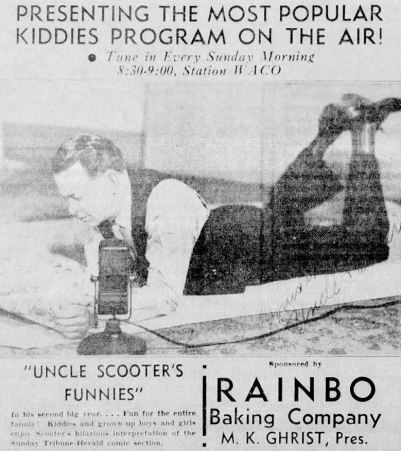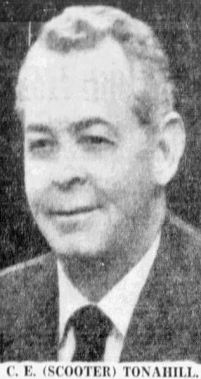Jack Walton’s Hot Barbecue

Restaurant No. 1, Haskell & San Jacinto…
by Paula Bosse
Arden Lee “Jack” Walton was born in Panola County (on his World War I registration card, he listed his home as Fairplay, Texas, which a town name I’m certainly glad to know exists). After the war, he moved to Dallas and opened his first restaurant — Walton’s Place — around 1925 or 1926. By the 1930s, he seems to have settled on barbecue as his primary specialty and had several of his self-named restaurants/drive-ins around town, branching out to Fort Worth in the early ’40s.
The photo above, from about 1946, is probably Walton’s first location, at Haskell and San Jacinto in Old East Dallas. The two photos below — showing a man working on the neon sign — were taken at the same time. (The photographer, James Bell, was a Dallas native back in town visiting — he took tons of unusual photos, often focusing on trucks, buses, cars, juke boxes, and various coin-operated machines. I’m sure he liked the look of the truck. They’re definitely amateur photos, but they’re great.)
The photo that crops up on places all over El Internet (the photo below) is one which has a variety of conflicting information attached to it, including photographer, date, and location. As far as I can tell, I think the photo was taken by Arthur Rothstein in Fort Worth, in the very early ’40s (the FW location, at 1900 E. Lancaster, opened around 1940). I think most of the locations had a similar design. (See a typical menu here.)
Here’s another photo (location unknown):
 from the book Smokelore
from the book Smokelore
Walton was very successful in his toasted sandwich endeavors (he also made some savvy real estate deals). When he died, he was described as “the barbecue baron of Dallas.”
…When he died. Jack Walton died on Feb. 19, 1960, at the age of 62. He was visiting one of his restaurants, at Tom Field Circle and Hwy. 183. The manager — Jack’s brother-in-law — had been drinking on the job, and Jack fired him on the spot. So the brother-in-law shot him, telling the police later that Walton “started fussing at me and told me to get out.” He shot him at close range, so inebriated that only two of the shots hit their target. He was DOA at Baylor. (Read the AP wire story here.)
At least one of Walton’s restaurants was taken over by the Semos family — the Haskell location lasted under non-Walton management for quite a while.
*
When I saw this matchbook cover several years ago, I was quite taken with the phrase “toasted chicken loaf.” What was a “chicken loaf”? I have to say, it didn’t sound that appetizing.
Chicken loaf was (apparently) a very popular food in days gone by, similar to meat loaf (it was made with chopped, shredded, or minced chicken, eggs, breadcrumbs/rice/some sort of cereal, etc., with the addition of hard-boiled eggs and/or pimentos and/or peas and/or whatever else was lying around). There are lots of ads in newspapers beginning around 1900 showing it as a “potted” meat, sold in cans alongside Underwood Deviled Ham and Vienna sausages, etc. I can understand this as a cost-saving meal during the Depression, but it was also very popular in restaurants (several local restaurants advertised that they sold entire take-out “loafs”), and it was a favorite of many as a Sunday dinner (or as a way to use leftover chicken in the pre- and post-casserole days). By the ’40s, recipes started adding the dreaded gelatin (“Jellied Chicken Loaf”). Um, yes. There was also … wait for it … MOCK chicken loaf! I’m not sure what that was, but it probably got people through WWII and food-rationing.
While searching for “chicken loaf” info in the Dallas Morning News archives, I saw a few delicacies listed in grocery ads which one might be hard pressed to find on the shelves of one’s local supermarket today: oyster loaf, liver loaf, and deviled tongue — all sold in cans. There was also a New Year’s Eve recipe in there for “Hot Sardine Canapes,” with toast “cut in fancy shapes.”
FYI.
***
Sources & Notes
First three photos were taken by James Bell in about 1946; they are from the James H. Bell Collection, Dallas Historical Society — they can be accessed here, here, and here. (I have straightened and cropped the photos.)
The photo which is probably by Arthur Rothstein is from the Traces of Texas Facebook page.
Menu detail art is from Worthpoint; matchbook scans from eBay.

*
Copyright © 2023 Paula Bosse. All Rights Reserved.








































 Fort Worth Star-Telegram, Sept. 1940
Fort Worth Star-Telegram, Sept. 1940 FWST, Sept. 1940
FWST, Sept. 1940 FWST, March 1941
FWST, March 1941

 1940
1940 1954
1954 1939
1939















 Olive West (1890-1950)
Olive West (1890-1950)


